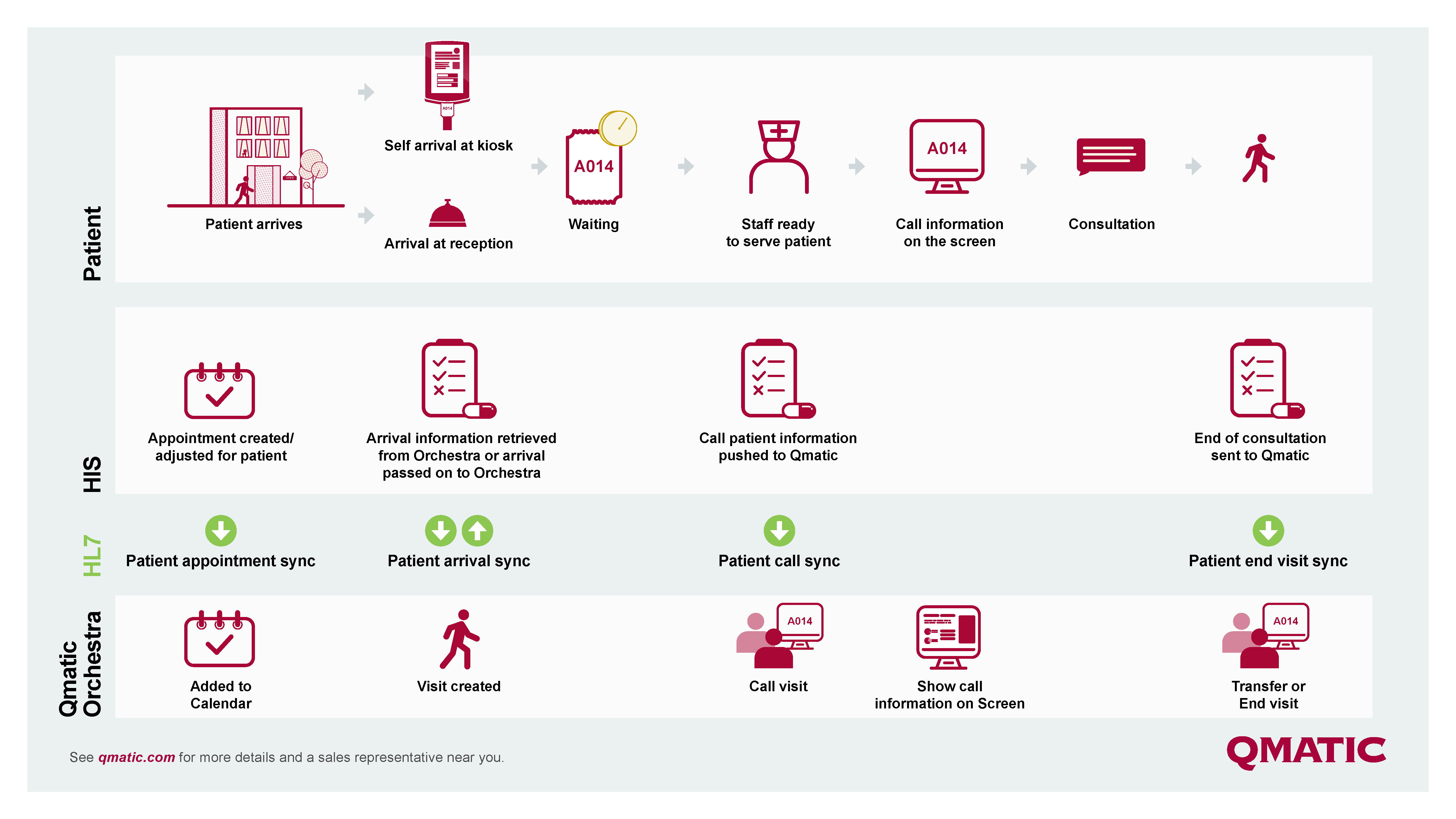- Blog Overview
- Knowledge
- Integrating a patient journey manager with a hospital information system using HL7

Integrating a patient journey manager with a hospital information system using HL7
The Qmatic Team |October 21 2020 | 8 min
Managing patient journeys is the key to an improved patient experience, a better quality of care, and increased efficiency. Many healthcare decision-makers have noted the importance of using a patient journey management system, but face challenges in optimizing and integrating it with their hospital information system (HIS). In this article, we will explain about HL7 middleware, the key to system integration in the healthcare sector, and how HL7 workflow solution can improve the quality of care.
System integration in the healthcare industry
What is HL7?
The HL7 format is an international standard, which guarantees a high level of detail in the transmission of medical information and therefore ensures reliable exchanges of patient data between hospital systems, and in our case, a patient journey management (PJM) system. HL7 middleware is an international-standard device that supports and facilitates data transfer from clinical devices to information systems in hospitals. A patient journey management solution can be easily integrated with a Hospital Information System (HIS) by using HL7 middleware.
This fluidity in the exchange of information allows the creation and updating of all information related to the identity of patients (name, date of birth, address, telephone numbers, etc.).
Each patient is identified by a unique identifier which is known to all the applications of the hospital. It is on this unique identifier that the exchanges and the updates are based.
How hospital system integration can help solve the problems
The development of HL7 middleware to integrate patient journey management solutions with the hospital information system was done with customer needs in mind. Using the most common challenges and questions encountered in the healthcare sector as a base, here are some of the few questions that were addressed during the development:
- How to retrieve patient data?
- How to synchronize with the HIS interface
- How to integrate all relevant information with the patient journey management system
- How to update patient records so that they correlate with the information displayed in the patient journey management system
What does HL7 integration do?
Integrating a patient journey management system with a HIS will create a seamless process and workflow for staff and patients. Among other things, healthcare providers will have the ability to:
- Retrieve thousands of daily HL7 files relating to patient appointments at the hospital in question from a data well.
- Analyze and process this data, by organizing and distributing it to the sites and services corresponding to the HL7 parameters recovered. The integration of this data is based on the tree structure predefined in the customer configuration.
- Create logs which list all the integrated appointments. These detailed, daily reports make it easy to find missing items in the original HL7 files, and as such, the technical exchange with the IT teams of healthcare establishments is more optimal as the coordination of information is simplified.
Apart from that, healthcare providers can also:
- Synchronize appointment data
- Call and redirect patients
- Check in patients
- Get access to real-time data insights that display average waiting times, treatment times, and the number of patients waiting
- View queue information
- Manage patient registration from a touchscreen
- Have a visual interface to configure the most common healthcare flows
Patient journey management software integration with HL7
What are the results of patient flow solutions integration with HL7?
The patient appointment is directly associated with the service and the corresponding attending physician. Each piece of information in the HL7 messages exchanged is stored in a specific location, thus guaranteeing the consistency of the information.
An interface is thus available which makes it possible to integrate the messages and to carry out the necessary checks on the information contained, before taking them into account. The different information present in the HL7 files makes it possible to identify each movement by a unique number. We can thus update any movement independently of the others.
The healthcare establishment thus offers the patient an optimized and connected journey that facilitates reception. The patient's stay has become more pleasant and less stressful.
HL7 workflow solution
How does medical information transmission between a patient journey management software and hospital information system work with HL7?
Here is an example of a patient journey, and how HL7 connects a hospital information system (HIS) with a patient journey management software (Qmatic Orchestra).

In the illustration above, you can see how HL7 transmits medical information between the PJM and HIS in several touchpoints:
- Pre-arrival: Appointments created or adjusted for patients within the HIS is synchronized to the patient journey management system
- Arrival: Arrival information retrieved from the HIS is passed to the patient journey manager, and vice versa
- Service: When the staff member is ready to serve a patient, the call patient information from the HIS is sent to the patient journey management system, allowing the PJM system to show the call information on a screen or mobile ticket. The same happens at the end of consultation, where a notification will be sent to the PJM to end the visit.
What are the benefits of HL7 integration?
Integration with HL7 will provide seamless support for patient flows within healthcare, which allows healthcare providers to manage appointments, walk-ins, and emergency patients from arrival to discharge. This gives management and healthcare professionals the possibility to deliver the best possible care for patients with an optimized patient journey and efficient utilization of healthcare resources.
With an integrated patient journey management solution, healthcare providers can better inform patients who are waiting for the treatment(s). This can be done by posting information about appointment numbers, location information, wait times and other important messages on dedicated screens throughout the hospital environment. This ensures that patients stay updated about service and wait time specifics, which reduces uncertainty and dramatically speeds the service process by calling patients forward at the right time.
The bottom line is, integrating a HIS to a PJM system provides you with easy access to operational data and analysis of your healthcare facilities. This will bring more streamlined processes, increased efficiency, and better quality of care.
Other benefits of integration with HL7 middleware:
- Easy access to powerful functionality
- Time-saving
- Secure
If you’d like to learn more about a patient journey manager and the hospital information system with HL7 middleware, download our guide on HL7 integration below.




